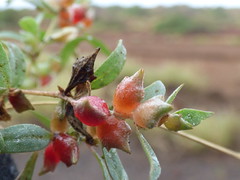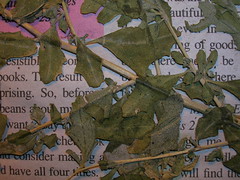R.Br., Chenopodiaceae

|

|

|

|

|
|
R.Br., Chenopodiaceae |
|
Present on Pacific Islands? yes
Primarily a threat at high elevations? no
Risk assessment results: High risk; score: 13 (Hawaii-Pacific Weed Risk Assessment for Atriplex semibaccata)
Other Latin names: (no species-level synonyms found)
Habit: herb
Description: "Australian saltbush (Atriplex semibaccata) is a drought-tolerant, low-growing shrub with silvery gray evergreen foliage and small red fruit. It forms a dense groundcover that is fire retardant. The dense mat is less than one foot tall, spreading up to six feet or more across." (Invasive Plants of California's Wildlands)
Herbs or subshrubs, perennial, decumbent-prostrate, unarmed, mainly 0.5-8 dm and spreading to 15+ dm wide, unarmed, white scurfy when young; branches not angled. Leaves many, alternate, subsessile or short petiolate; blade 1-veined, spatulate or obovate to oblong or elliptic, mainly 5-30(-40) × 2-9(-12) mm, base attenuate, margin remotely dentate to subentire, apex obtuse. Staminate flowers in small, terminal, leaf-bracteate glomerules 1.5 mm wide. Pistillate flowers solitary or in few-flowered clusters in almost all but distalmost leaves. Fruiting bracteoles red-fleshy at maturity, sessile or short stipitate, strongly veined, rhombic, convex, 3-6.6 × 2.8-4.5 mm, united at base, margin toothed, apex obtuse to acute. Seeds dimorphic: black, 1.5-1.7 mm, or brown, 2 mm. 2n=18. Flowering spring-early winter. The red-fleshy fruiting bracteoles are diagnostic of this perennial species, which is multi-stemmed from an often buried woody caudex. (adapted from Flora of North America)
(See also Invasive Plants of the World (Weber, 2003), p. 62.)
Habitat/ecology: "A ground-spreading plant that displaces native species. In the native range, it is a pioneer species of eroded soils. Once established it persists and may become dominant over large areas. Stands of this plant are species poor. Seeds are produced in large numbers and dispersed by birds." (Invasive Plants of the World (Weber, 2003), p. 62)
Native littoral habitats include coastal areas, dunes, and salt marshes; native terrestrial habitats include arid regions, deserts, and natural grasslands (CABI datasheet). Invaded habitats include saline places, coastal salt marshes, shrubland, and woodland (Invasive plant species of the world (CABI), p. 62).
Propagation: "Seeds are produced in large numbers and dispersed by birds." (Invasive Plants of the World (Weber, 2003), p. 62)
"A[triplex] semibaccata reproduces by the production of seed. Plants have separate male and female flowers on the same plant, though possible pollinators or means of pollination is unknown. However, other Atriplex species are self-compatible and wind-pollinated, suggesting this also may be the case with A. semibaccata. The fruiting bracteoles split into two when ripe and dry, exposing a single seed (Cal-IPC, 2015). The degree of persistence of seeds in soil and germination conditions are unknown. A. semibaccata produces large numbers of fruits and seed and like many other species of the genus, does not appear to exhibit any characteristics of dormancy, with high germination rates with no pre-treatment recorded (Florabank, 2015). De Villiers et al. (1994) found an optimum of 21°C for germination, while IFFA (2010) indicates that germination may be aided by soaking seeds for several hours to dilute and flush chemicals that inhibit germination." (Flora of North America @ efloras.org)
Native range: Atriplex semibaccata is native to all states in Australia except the Northern Territory and Tasmania (Invasive plant species of the world (CABI), p. 63).
Impacts and invaded habitats: Invaded habitats: "Coastal estuaries, salt marshes, coastal dunes and scrub, woodland." (Invasive Plants of the World (Weber, 2003), p. 62)
Presence:
| Pacific | |||
|
Country/Terr./St. & Island group |
Location |
Cited status &
Cited as invasive & Cited as cultivated & Cited as aboriginal introduction? |
Reference &
Comments |
|
State of Hawaii
Hawaiian Islands |
Burm Island | Consortium of Pacific Herbaria (2018) | |
|
State of Hawaii
Hawaiian Islands |
Hawaiian Islands |
invasive
|
Holm, Leroy/Pancho, Juan V./Herberger, James P./Plucknett, Donald L. (1979) (p. 39)
(C)ommon weed |
|
State of Hawaii
Hawaiian Islands |
Hawaiian Islands |
introduced
|
Weber, Ewald (2017)
cited as invasive in SWUSA, "naturalized" in Hawaii, western USA, Meditteranean Africa/S. Europe, and western S. America |
|
State of Hawaii
Hawaiian Islands |
Hawaiian Islands |
introduced
|
CAB International (2017) (p. 63)
"Naturalized (species has established populations" |
|
State of Hawaii
Hawaiian Islands |
Lāna‘i Island | Consortium of Pacific Herbaria (2018) | |
|
State of Hawaii
Hawaiian Islands |
Maui Island | Consortium of Pacific Herbaria (2018) | |
|
State of Hawaii
Hawaiian Islands |
Moloka‘i Island | Consortium of Pacific Herbaria (2018) | |
|
State of Hawaii
Hawaiian Islands |
O‘ahu Island | Consortium of Pacific Herbaria (2018) | |
|
Marshall Islands
Ratak Chain |
Wotje (Wõjjã) Atoll | Consortium of Pacific Herbaria (2018) | |
| Pacific Rim | |||
|
Country/Terr./St. & Island group |
Location |
Cited status &
Cited as invasive & Cited as cultivated & Cited as aboriginal introduction? |
Reference &
Comments |
|
Australia
Australia |
Australia |
invasive
|
Holm, Leroy/Pancho, Juan V./Herberger, James P./Plucknett, Donald L. (1979) (p. 39)
(X)=present as a weed (but importance rank unknown) |
|
Australia
Australia (continental) |
Australia (continental) | Consortium of Pacific Herbaria (2018) | |
|
South America (Pacific rim)
South America (Pacific rim) |
Chile (Republic of) |
invasive
|
Holm, Leroy/Pancho, Juan V./Herberger, James P./Plucknett, Donald L. (1979) (p. 39)
(X)=present as a weed (but importance rank unknown) |
| Also reported from | |||
|
Country/Terr./St. & Island group |
Location |
Cited status &
Cited as invasive & Cited as cultivated & Cited as aboriginal introduction? |
Reference &
Comments |
|
South America
South America |
Argentina |
invasive
|
Holm, Leroy/Pancho, Juan V./Herberger, James P./Plucknett, Donald L. (1979) (p. 39)
(C)ommon weed |
|
United States of America
United States |
United States |
invasive
|
Holm, Leroy/Pancho, Juan V./Herberger, James P./Plucknett, Donald L. (1979) (p. 39)
(X)=present as a weed (but importance rank unknown) |
Comments: Life form: herb/subshrub (Flora of North America); present in Hawaii per present in Hawaii per Alien plant invasions in native ecosystems in Hawaii, p. 134
The name Atriplex semibaccata Moq. (nom. illeg.) is cited by The Plant List.
Control: "Plants can be easily hand-pulled, the best time is before seeds develop. Chemical control for closely related taxa (Kochia scoparia, Salsola tragus) include 2,4-D, dicamba, or picloram plus 2,4-D. Follow-up programmes are necessary to control any emerging seedlings." (from Bossard et al (2000) as cited in Weber 2017; also, Invasive Plants of the World (Weber, 2003), p. 62)